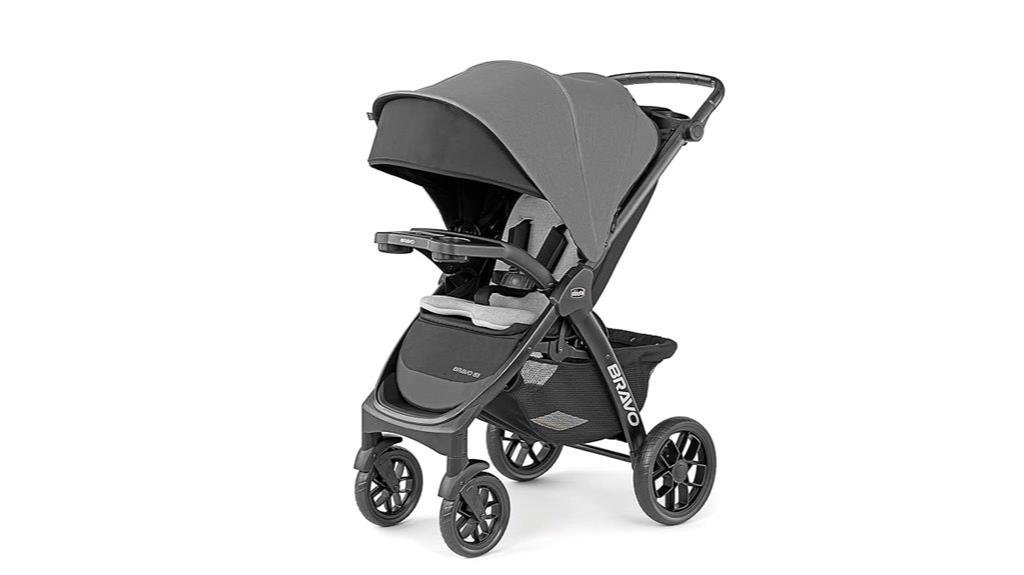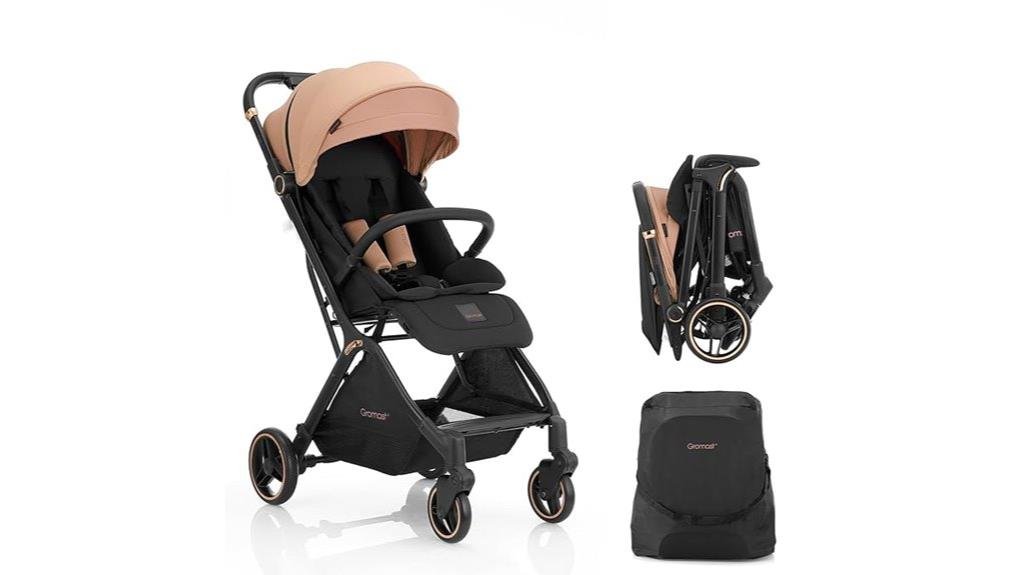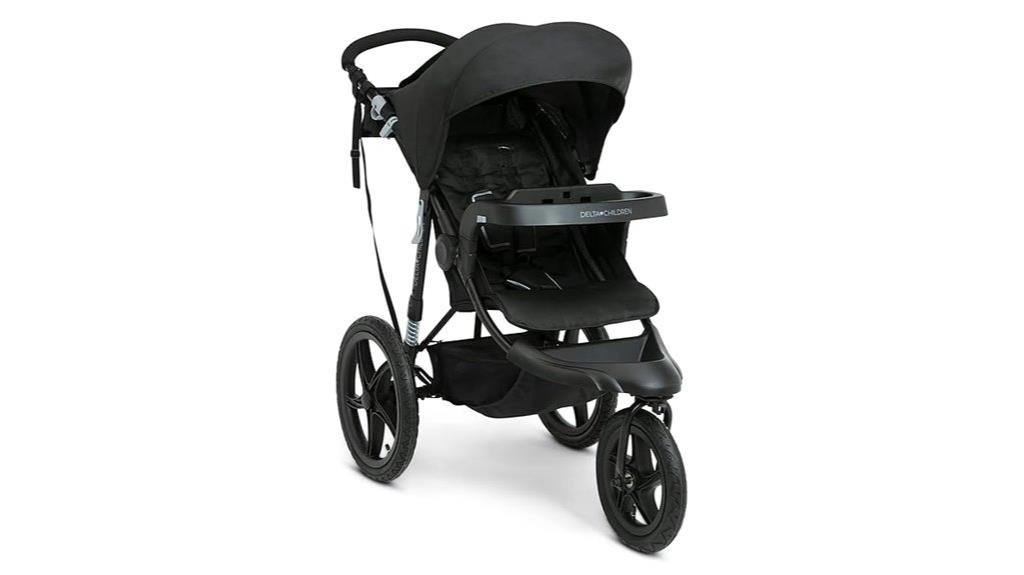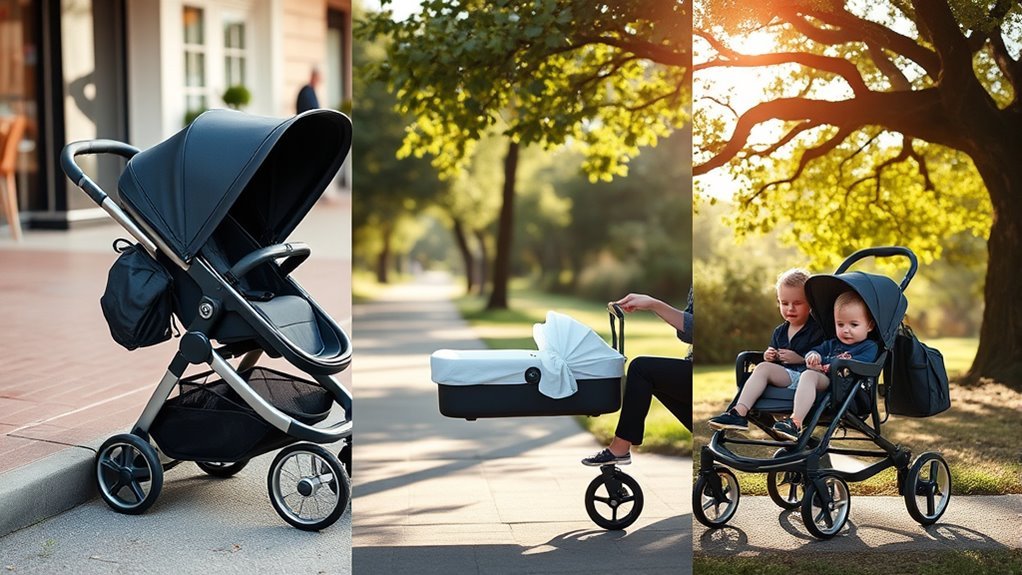We’ve tried a range of strollers so we can recommend options that actually work as your child grows. Here are three versatile picks that balance safety, comfort, and convenience for babies and toddlers. We’ll outline what each does best and what trade-offs to expect — so you can quickly spot the right fit for your family.
Chicco Bravo LE ClearTex Full-Size Stroller for Babies and Toddlers

If you need a full-size stroller that grows with your child, the Chicco Bravo LE ClearTex is a smart pick—its three modes let you use it as a lightweight car-seat carrier, travel system, or full toddler stroller, so you won’t buy a new pushchair every time your baby outgrows a stage. You’ll appreciate the one-hand compact fold that stands upright, large UPF 50+ canopy with peek-a-boo mesh, removable reversible padded seat, and easy-grip three-position handle. All-wheel suspension, treaded wheels, rear-linked brakes, and a five-point harness keep rides smooth and secure. It’s GREENGUARD Gold certified and rated highly by parents.
Best For: Parents who want a versatile, full-size stroller that adapts from infant car-seat carrier to travel system to toddler stroller while offering comfort, safety, and easy one-hand folding.
Pros:
- GREENGUARD Gold certified with a UPF 50+ canopy, promoting healthier air quality and sun protection.
- One-hand compact fold that stands upright, removable reversible padded seat, and three-position handle for convenience and longevity.
- All-wheel suspension, treaded tires, rear-linked brakes, and a five-point harness for smooth, secure rides on uneven terrain.
Cons:
- At 26.5 pounds, heavier than many lightweight umbrella strollers for travel.
- Maximum weight recommendation of 50 pounds may limit long-term use for larger toddlers.
- Made with 2% PVC, which some buyers may prefer to avoid despite low emissions certification.
Gravity Folding Baby Stroller (Portable Travel Toddler Stroller)

Parents who travel often will appreciate the Gromast Gravity Folding Baby Stroller, since its self-standing auto-fold and 16 lb frame make airport changes and tight spaces much easier to manage. You’ll like the quick gravity fold that locks upright and fits compactly at 21 x 28.4 x 13 inches for flights. The extra-wide padded seat with a 5-point harness, adjustable backrest and footrest, and all-wheel suspension keep your child comfy over varied terrain. A zip-out UPF50+ canopy with peek-a-boo window, decent storage basket, instant one-step brake, and included carry bag and cup holder finish this travel-ready setup.
Best For: Parents who travel frequently and need a lightweight, compact, easy-to-fold stroller for infants and toddlers (0–3 years) that fits in tight spaces and on flights.
Pros:
- Self-standing auto-fold with gravity quick-fold makes folding/unfolding fast and convenient for travel.
- Lightweight 16 lb aviation-grade aluminum frame and compact folded size (21 x 28.4 x 13 in) are highly portable.
- Comfortable for children with extra-wide padded seat, 5-point harness, adjustable backrest/footrest, and all-wheel suspension.
Cons:
- May lack some features of full-size strollers (e.g., larger storage capacity or enhanced recline options) due to its travel-focused, lightweight design.
- Khaki color and UV-resistant fabric could show wear or stains more visibly over time.
- Best for ages 0–3 only, so not suitable as a long-term stroller solution beyond toddler years.
Delta Children Apollo Jogging Stroller (Black)

The Delta Children Apollo Jogging Stroller (Black) is a great pick for active caregivers who want a smooth, reliable run-and-walk option thanks to its shock-absorbing frame and puncture-proof 12″ front and 16″ rear wheels. You’ll appreciate the UPF 50+ extendable canopy with peek-a-boo window, adjustable foam handlebar, and multi-position reclining seat for naps. The 5-point harness with reflective piping, safety tether, brake system, and JPMA certification keep outings secure. It accepts several infant car seats with included or optional adapters, holds kids up to 50 lbs, folds compactly, and offers a parent organizer plus large storage basket.
Best For: Active caregivers who want a durable, smooth jogging stroller with good sun protection and safety features for children 9 months and up (up to 50 lbs).
Pros:
- Shock-absorbing frame with puncture-proof 12″ front and 16″ rear wheels for a smooth, low-maintenance ride.
- UPF 50+ extendable canopy with peek-a-boo window, multi-position reclining seat, and adjustable handlebar for comfort and convenience.
- Includes safety features (5-point harness with reflective piping, safety tether, brake system) and compatibility with several infant car seats (adapter included for some).
Cons:
- Relatively heavy at 33 lbs, which may be cumbersome for lifting or frequent car transport.
- Warranty is short (90 days) compared with many strollers that offer longer coverage.
- Some car seat adapters for popular brands (Britax, Chicco) are sold separately.
Factors to Consider When Choosing a Stroller for Baby and Toddler
Now let’s look at the key factors that help us pick the right stroller for both baby and toddler. We’ll cover age and weight limits, safety certifications, maneuverability and wheels, foldability and portability, plus comfort and adjustability. Keeping these points in mind will make it easier to find a model that’s safe, practical, and comfortable for everyday use.
Age and Weight Limits
Because children grow quickly, we need to check both age and weight limits before choosing a stroller to make certain it stays safe and comfortable as our child develops. We should verify the maximum weight capacity—many models top out around 50 pounds—to guarantee longevity through toddlerhood. Age recommendations matter too: some strollers support infants from birth, while others are intended for babies 9 months and older. That influences features and design: convertible seats suit infants shifting to toddlers, whereas lightweight models often target younger kids and jogging strollers typically require a minimum age (about 9 months) for active use. We also confirm that the stroller’s restraints, like a 5-point harness, match the child’s size for secure seating at each stage.
Safety and Certification
When we’re choosing a stroller, safety certifications and built-in protections should be our top priorities so we recognize it’s been tested and designed to keep our child safe. We should confirm JPMA certification to know the stroller meets established safety requirements and has undergone durability testing. A 5-point harness is nonnegotiable; it keeps infants and toddlers securely seated during turns, bumps, and sudden stops. We also look for GREENGUARD Gold certification to minimize chemical emissions and protect indoor air quality for sensitive little ones. Nighttime visibility features, like reflective piping, add an important layer of safety for evening walks. Before buying, we verify test reports and labels so we’re confident the stroller complies with industry standards.
Maneuverability and Wheels
How do we make certain a stroller glides smoothly over sidewalks, curbs, and park paths? We look at wheels and maneuverability first. Larger wheels roll over uneven terrain and give a smoother ride, while all-wheel suspension absorbs bumps so our child and we stay comfortable. Swivel front wheels let us pivot easily in tight spaces like stores or crowded sidewalks, improving navigation without awkward tugs. A lightweight frame complements good wheels, making the stroller easier to push and steer throughout the day. For control and safety, we want reliable rear-linked foot brakes that secure the stroller on slopes or when parked. Balancing wheel size, suspension, swivel capability, and frame weight guarantees confident, comfortable handling for growing families.
Foldability and Portability
If we plan to move between errands, park paths, and flights, foldability and portability should be top priorities. We should prioritize a one-hand compact fold so we can collapse the stroller while holding a child or bag. Lightweight models—typically 16 to 26.5 pounds—make lifting and carrying less taxing, especially up stairs or into car trunks. Check folded dimensions to guarantee the stroller fits overhead bins and tight trunk spaces. An upright fold is handy: it keeps the handle off the ground for cleanliness and saves room. When time is tight, an auto-fold mechanism offers fast shifts and less fumbling. Balancing weight, folded size, and ease-of-use helps us pick a stroller that travels smoothly with our growing family.
Comfort and Adjustability
Because our child’s needs change fast, comfort and adjustability should be front and center when we choose a stroller. We look for adjustable backrests and footrests so the seat fits newborns through toddlers and provides ergonomic support as they grow. A padded, extra-wide seat with a 5-point harness keeps them secure while allowing natural movement. Multi-position reclining lets us shift between upright play and flat naps without disturbing the child. For smoother outings, we prioritize superior shock absorption and all-wheel suspension to handle sidewalks, gravel, and park paths. An adjustable canopy with UV protection and ventilation options completes the package, giving sunshade and airflow for outdoor comfort. These features keep both child and caregiver comfortable on every outing.
Frequently Asked Questions
Can I Use These Strollers With Infant Car Seats (Click-In Compatibility)?
Yes — many of these strollers accept infant car seats with click‑in adapters, but compatibility varies by brand and model, so we recommend checking the stroller’s manual and your car seat’s fit list before purchasing to guarantee a secure connection.
Are Replacement Parts Readily Available for These Models?
Like roots gripping soil, yes — we can usually find replacement parts for these strollers; manufacturers and third-party sellers stock wheels, brakes, fabrics, and adapters, so we’ll replace worn pieces and keep your stroller running smoothly.
Do Any of These Strollers Fit Through Narrow Airplane Aisles?
Some do: we’ve found a few ultra-compact models that fit narrow airplane aisles, but most full-size strollers won’t. We’ll recommend checking folded width specs and airline gate-check policies before traveling with one.
Can I Wash or Sanitize the Upholstery and Straps Easily?
Like a washboard renewing linens, yes—we can usually remove and machine-wash seat fabrics and wipe straps with gentle soap; for stubborn stains or sanitizer use, we’ll follow the manufacturer’s tag to avoid fading or damaging water-resistant coatings.
What Warranty and Customer Support Options Do Manufacturers Offer?
Manufacturers typically offer limited warranties (frame, parts) from one to ten years and one-year coverage for fabric/finish; we’ll help you register products, use customer support lines, online chat, and authorized service centers for repairs or replacement.
Conclusion
We’ve walked you through three strollers that fit different chapters of family life — the Chicco Bravo LE for everyday ease, the lightweight Gravity for quick escapes, and the Delta Apollo for active runs. Picture mornings unfolding: a folded stroller clicking into our car, a smooth jog beside sunlit trees, a toddler napping snug against breathable ClearTex. With these choices, we’re ready to roll into new routines, confident and connected.
